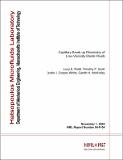Capillary Break-up Rheometry of Low-Viscosity Elastic Fluids
Author(s)
Rodd, Lucy E.; Scott, Timothy P.; Cooper-White, Justin J.; McKinley, Gareth H.
Download04-P-04.pdf (1.452Mb)
Metadata
Show full item recordAbstract
We investigate the dynamics of the capillary thinning and break-up process for low viscosity
elastic fluids such as dilute polymer solutions. Standard measurements of the evolution of the
midpoint diameter of the necking fluid filament are augmented by high speed digital video
images of the break up dynamics. We show that the successful operation of a capillary thinning
device is governed by three important time scales (which characterize the relative importance of
inertial, viscous and elastic processes), and also by two important length scales (which specify
the initial sample size and the total stretch imposed on the sample). By optimizing the ranges of these geometric parameters, we are able to measure characteristic time scales for tensile stress growth as small as 1 millisecond for a number of model dilute and semi-dilute solutions of polyethylene oxide (PEO) in water and glycerin. If the aspect ratio of the sample is too small, or
the total axial stretch is too great, measurements are limited, respectively, by inertial oscillations of the liquid bridge or by the development of the well-known beads-on-a-string morphology which disrupt the formation of a uniform necking filament. By considering the magnitudes of the natural time scales associated with viscous flow, elastic stress growth and inertial oscillations it is possible to construct an “operability diagram” characterizing successful operation of a capillary break-up extensional rheometer. For Newtonian fluids, viscosities greater than approximately 70 mPa.s are required; however for dilute solutions of high molecular weight polymer the minimum viscosity is substantially lower due to the additional elastic stresses arising from molecular extension. For PEO of molecular weight 106 g/mol, it is possible to
measure relaxation times of order 1 ms in dilute polymer solutions of viscosity 2 – 10 mPa.s.
Description
Submitted to Applied Rheology, August 2004
Date issued
2004-11-01Series/Report no.
04-P-04;
Keywords
capillary thinning, extensional rheometry, viscoelastic fluid